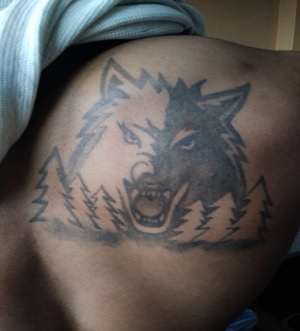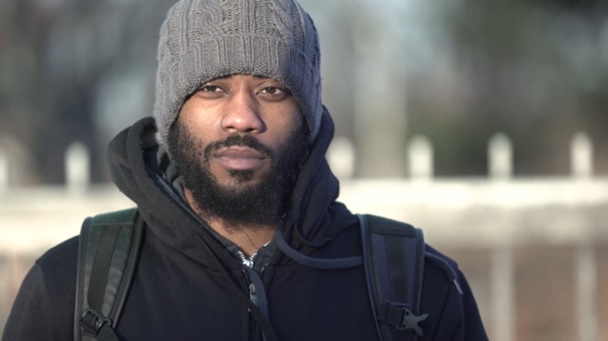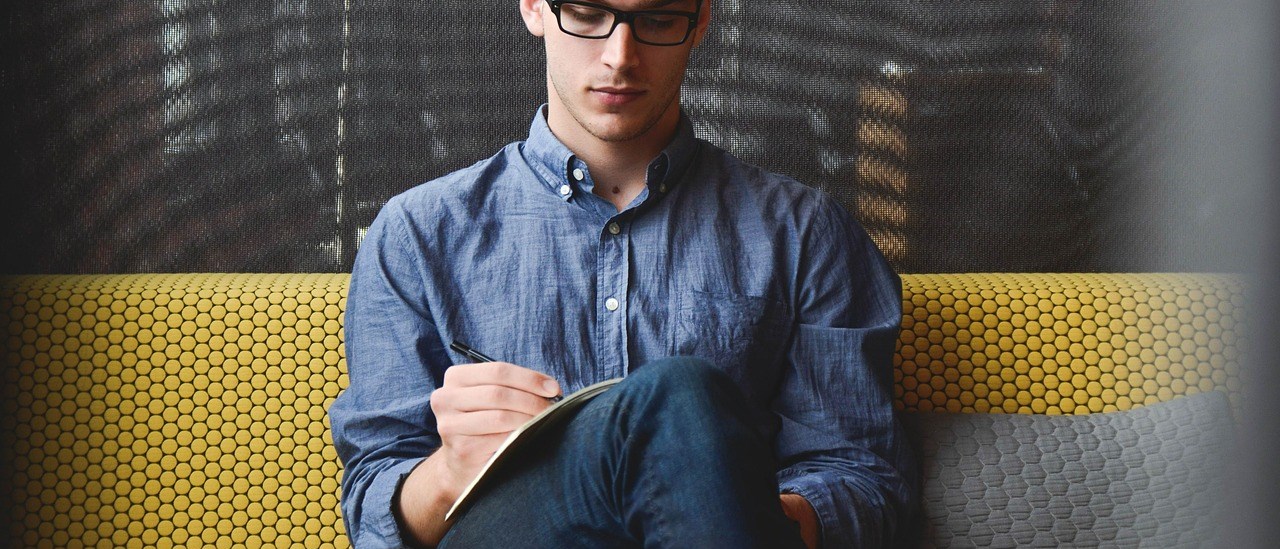Paul Burns sits behind a battered wooden desk. He meticulously takes notes from his book “HVAC Fundamentals: Volume 1: Heating Systems, Furnaces and Boilers,” studying the craft of heating and ventilation repair. He bends his head towards the book and whispers the sentences in chapter nine: “Indoor Air Fundamentals.” He pulls up his shirt’s sleeves. Both his arms are full of tattoos.
“I got a couple tattoos. I got some rose on my arm. My grandmother’s name. She passed away a couple of months ago. “A lot of this is jail work,” he says, pointing at his left arm. “This are the buildings that surrounded the prison. That is my brother’s name and that one is my daughter’s name. This is the name of a friend of mine that passed away on the streets. He got shot.”
Paul Burns was 12 years old when he got his first charge for a violent crime. “It was my first week of middle school,” Paul says, “I got into a bus and then this kid walked back to me and started swinging mad crazy. I punched him off and he grabbed me.” In the middle of the fight, Paul remembered that he had a small knife in his pocket. “So I just started stabbing the kid. I stabbed him,” he says.
Paul grew up in Roxbury with his mother, two older brothers and a younger brother. His father struggled with alcohol and drug addiction, and was never around. His older brothers were either out of town or incarcerated.
He spent a lot of time out in the streets, exposed to violence. “I was getting myself in some sort of trouble,” Paul says.” At 17, he was charged with unlawful possession of a firearm and sentenced to five years in prison. “That was like a big waste of time,” he says. “Jail was a big waste of time.”
Paul is one of the 900 students in the College Bound Dorchester program, which helps people who have been in prison rejoin society and build new futures by helping them resume their education. Most of the students are high-school drop-outs, studying to pass their General Educational Development test, also known as the GED. Some others are preparing for college. The program’s goal is to enroll 250 of their students in college in the next two years.
“These are guys who have heard that they can never do well. They’ve never heard ‘you can be a CEO or an entrepreneur.’ They’ve only heard they can do bad things. We believe you guys can do this. We just motivate them to reach their potential,” says Lealah Fulton, who works at College Bound Dorchester.
Paul’s glasses slide down to the tip of his nose. He pushes them back up with his left hand. His right hand holds a black gel-ink pen. He presses it against the lines he reads: “Figure 7-1 shows all the components of a forced-air system,” and looks at a technical drawing that shows air tubes and the inside of an air conditioner system.
The text continues: “A blower, located in a unit called an air handler, forces the conditioned air through the ducts. In many residential systems, the blower is integral with the furnace enclosure,” Paul frowns.
Right after, he repeats two or three times over the same paragraph. Finally, he nods and continues to the next one.
“If it wasn’t for this program, I know that I would be doing something negative,” says Paul. But for him, accepting the help when he first got into College Bound Dorchester was not easy. “I didn’t really accept the process at first. The teachers are good, the counselors are good. But it took me two years to understand what this was about. Now I come to class, to talk to people or to eat, or just to be here. It’s more than a school, it really is like a second home,” he says.
But sometimes he still finds it hard to stay focused. “A couple of months ago, before I had my GED, I was ready to drop out every day. Feeling like, ‘the hell with it, I can pick up a little bit of drugs or picking up a half-time job,’ but it would lead to bullshit. To a spiral of me backpedaling. I don’t want to backpedal,” Paul says.
Luis Rodriguez, a program influencer at College Bound Dorchester, tries to keep Paul motivated and focused on his goals. Rodrigues used to be a gang leader. He spent 10 years in prison for drug-related crimes. His life experience has made him a positive influence for ex-convicts. He is someone they can trust.
“I hang out with Luis a lot because he is the person I knew when I was in jail. He is one of those people: good, resourceful, intelligent. And he is not going to sugar coat it,” says Paul.
Rodrigues walks everyday to College Bound Dorchester from his house, a couple of blocks away from the center. He believes that being part of the community and the experience he had on the streets, make it easier for him to reach out to young women and men from the neighborhood that could benefit from the program.
“It’s easy for other people to say: ‘Hey, go to school, get a job’, but how do you know? You don’t live in this neighborhood, you don’t live in this jungle. You don’t go through what we go through,” Rodrigues says. “It’s never too late to get things in order.”
In March, the Boston Police Department recovered 18 unauthorized guns, most of them in Roxbury, Dorchester and Mattapan. 12 of them were seized from alleged gang members conducting drug operations. For people like Paul, gun violence is still too much of a real threat. “Even right now. I woke up this morning, on my way here: two dudes get shot 10 minutes away from my house. One of them is dead.” Paul says.
“Every day I know I have to come here, and still there is a possibility of dying coming here or leaving here,” says Paul, “not just for me, but for every student, everyone has that same problem. Guns right now, they’re just like cellphones, bro. Modern fashion, or whatever it is. You just have to have one.”
Paul’s fear is not imaginary. According to a 2016 study from the American Journal of Medicine, in comparison with other high-income countries, the United States’ gun homicide rate is 25 times higher. According to the same study, on average 30 people will die by a gunshot each day.
In Boston, police reports from 2017 indicate that there were 52 homicides by gun shot. 42 of them happened in Dorchester, Roxbury and Mattapan, the city’s poorest neighborhoods.
Paul Burns stands up and looks out the window. He focuses his sight in Dorchester’s houses. It is part of the active pauses his counselor Rodrigues recommended for him to endure his study hours. His hand reaches his left-front pocket. He takes out a small knife. He opens it, looks at the blade and then puts it back in his pocket.
“For protection,” he says. “I carry this knife for protection.” Paul cannot carry a gun. After a violent charge and two unlawful gun possession charges, carrying a gun would be his ticket back to jail. But he explains that in some parts of his neighborhood, he needs to carry something to protect himself.
The Centers for Disease Control and Preventions Multiple Cause of Death Database shows that 33,000 people are fatally shot in the U.S. each year. Usually, media focuses in horrific mass shootings, but a third of all gun deaths –about 12,000– are single homicides.
The same data shows an alarming number that may be an explanation of why Paul carries a knife: more than half of the homicide victims are young men; two-thirds of whom are black.
“In this life you have to fight sometimes. But 60 percent of the young men out here are scared to fist fight. You should be able to fight and not walk away. You don’t need to shoot people,” says Paul. “I don’t feel like I need to carry a gun. When I was young and immature I felt like a lot of people needed to get shot. But when you feel like you have a reason to live, you start to understand that not all the people need to die. It’s a big difference.”
A study by the Centers for Disease Control and Prevention, noted that the rate of death by gun violence for black people exceeds those among whites in all 50 states. For instance, in 2015, a black person living in Wisconsin was 26 times more likely to die by a gunshot than a white person.
When Paul was incarcerated, he asked an inmate to tattoo his back. He has a black and white wolf face he calls “a true work of art.” He explains that the wolf tattoo shows strength and “it kind of tells people to back off.”

For Boston University researchers, Molly Pahn, Anita Knopov and Professor Michael Siegel, mass shootings like the one that occurred in Las Vegas on November 5, in which a man walked into a church in Sutherland Spring, Texas, and killed 26 people, usually are the ones that get a lot of media attention, but they are not the deadliest ones.
In fact, they noted that the day before, 43 people were shot to death in cities and towns around the country.
In an article published in The Conversation, these Boston University scholars, call for action from a public health perspective to combat firearm violence as strongly as terrorism is battled.
“The first step in treating the epidemic of firearm violence is declaring that the everyday gun violence that is devastating the nation is unacceptable,” Pahn, Knopov and Siegel wrote.
Paul Burns shares his ideas, frustrations and anxious thoughts with Rodrigues. They not only meet at College Bound Dorchester. They often meet at Paul’s house and hang out together, to ease Paul’s worries and help him stay on track.
“I miss my brother a lot,” says Paul referring to his older brother Kelsy Wactor, who died of a heart attack. “Sometimes my life is not right. Sometimes I feel like I’m not mentally right, like I’m not financially right. Sometimes I feel that I haven’t had a day to just relax and not do anything. I feel like I’m taking a lot of responsibility and I know it’s not gonna stop. One day I want a break, but I gotta work for it.”

Mitchell Duneier, sociologist from Princeton, wrote the book Ghetto: the invention of a place, the history of an idea. In it he says that uprisings like the ones in Ferguson, Baltimore, and the growing Black Lives Matter movement, do not only answer to killings by police, but also express the discontent of economic exclusion, joblessness, housing insecurity, and debt and mass incarceration.
“I never really had someone to push me the extra step or push me like most people would have it. I mentally pushed myself there and told myself I could do it. I used to feel like I couldn’t, but every step I took I said ‘maybe I can do it.’ So, I’m doing better now,” says Paul.
After finishing his study session, Paul shoves his book and notebook inside his backpack. He wears a grey beanie. Then he puts on a black hoodie, covering most of his face. Right after, he descends four floors down the stairs and walks slowly toward the Red Line’s Ashmont T station.
Not every day is a bad day. Paul expects to get his diploma in August. For him, repairing air conditioners and heat systems represents the possibility of acquiring a steady income. He wants to save some money to build a house for his 3-year-old daughter, Kyndell. “I’m starting to understand and the engineering of air systems is fascinating,” says Paul, “I’m going to be self-sufficient, and it’s the best thing.”


